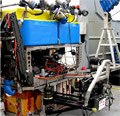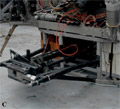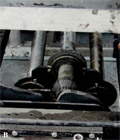operations
Drilling into Black Smokers
A drilling sled can be mounted on the robotic vehicle Jason 2 for drilling rocks on the ocean floor. As part of this program we will be using an underwater drill to recover core samples from actively venting black smokers and to make holes for insertion of incubation chambers (or sulfide microbial incubators) designed to examine the conditions under which life thrives within these extreme environments. The drill was designed at the Monterey Bay Aquarium Research Institution and transitioned to Woods Hole Oceanographic Institution for use on Jason 2. The drill can take four ~ 1" cores or cut four 3" diameter holes for follow-on instrumentation. The holes can be as long as ~20" in length. The core barrels are aligned in a horizontal position and, similarly to a lazy susan, can be rotated to allow new core barrels to be used after one drilling operation is finished.
The head of the bits that penetrate into the rock are covered in small, synthetically made diamonds that are hard enough to cut sulfide or basaltic rock. During drilling operations, Jason is commonly placed under computer control so that it remains very steady. The drill is turned on and slowly extended to meet the face of the chimney. A water pump circulates fluid into the hole as it is cut to keep it free of debris. The drill has become a very important tool for seafloor observatories: it was used in 2001-2003 to make holes for insertion of 7 short-period seismometers and 3 microbial incubators at the Endeavour Segment as part of the Keck and NSF observatory efforts.


